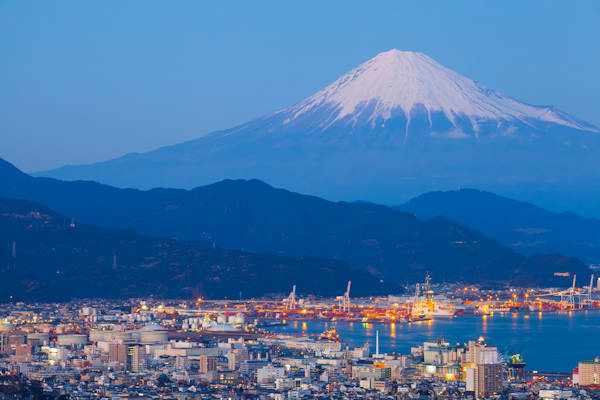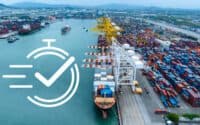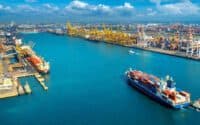A Beginner’s Guide to Japan’s Maritime Marvels

Japan’s been in the shipping game for ages. It started way back when ships were powered by the wind and has evolved into a high-tech, mega-efficient operation. After World War II, Japan really kicked things into high gear, modernizing their fleet and ports to become a global shipping powerhouse. They’ve been sailing ahead of the curve ever since, always looking for new ways to be faster, safer, and more efficient.
* Please send feedback/suggestions to editor @ shipuniverse.com
Key Components of Japan’s Maritime Shipping Industry
A. Major Ports and Their Roles
- Yokohama: Think of Yokohama as the front door to Japan’s economy. It’s super close to Tokyo and handles a ton of the country’s container traffic, making it a key spot for international trade.
- Tokyo: The big boss of Japanese ports, Tokyo is a hive of activity, buzzing with ships that bring in goods to keep the city and beyond ticking.
- Osaka: Sitting pretty in the Kansai region, Osaka is all about variety, dealing with everything from food to machinery, making sure the heart of Japan keeps beating strong.
- Nagoya: Nestled in Japan’s industrial belt, Nagoya is the muscle, handling heaps of cargo, especially cars, and showing off Japan’s manufacturing might to the world.
- Kobe: Kobe’s like the phoenix of Japanese ports. It rose from the ashes of the 1995 earthquake to become a symbol of resilience and innovation in maritime shipping.
B. Leading Shipping Companies
- Nippon Yusen Kabushiki Kaisha (NYK Line): The old-timer with a modern twist, NYK Line has been around since the samurai era, moving goods across the oceans with a fleet that’s as diverse as it is large.
- Mitsui O.S.K. Lines (MOL): MOL is the eco-warrior of the seas, focusing on transporting everything from oil to cars in the cleanest, greenest way possible.
- Kawasaki Kisen Kaisha (K Line): K Line is all about innovation, using the latest tech to transport cars, containers, and even energy in the slickest ways imaginable.
Operations and Logistics
A. Container Shipping Operations
Think of container shipping as the backbone of how we get pretty much everything from point A to B across the globe. Japan’s got this down to an art form. Their ports are like futuristic hubs, decked out with robots and automated systems that shuffle containers around like giant Tetris blocks. It’s all about making things quick and seamless, ensuring ships spend less time docked and more time cruising. Plus, they’ve got these massive ships that can carry loads of containers in one go, making the whole process super efficient and cost-effective.
B. Bulk and Liquid Transportation
Japan doesn’t just stop at containers; they’re big players in moving bulk goods and liquids too. We’re talking about everything from heaps of coal to massive tanks of oil and natural gas. They use special ships that are designed to carry these types of cargo safely over the seas. Japan’s strategic spot in Asia makes it super important for energy supplies, especially with their top-notch terminals and storage spots for all this stuff. Safety’s a big deal here, with tons of rules to make sure everything goes smoothly without harming the environment.
C. Supply Chain and Logistics Management
Getting things from the factory to your front door is a complex dance, and Japan’s logistics game is on point. They use all the tech toys – GPS, the Internet of Things, AI – to make sure everything moves like clockwork. This tech helps plan the best routes, keep tabs on inventory, and make sure deliveries are as quick as possible. It’s all about being smart and efficient, cutting down on costs and making sure customers are happy. Japan’s approach is all about seeing the big picture and making sure every piece of the puzzle fits perfectly.
D. Technological Innovations in Operations
Japan’s maritime industry is like the Silicon Valley of the seas. They’re all about pushing the envelope with tech – think drones, robots, and even ships that can pilot themselves. They’re also big on using blockchain for keeping track of shipping documents securely and transparently. And because they care about the planet, there’s a lot of focus on green tech, like ships that run on cleaner fuels and designs that cut down on energy use. These innovations aren’t just cool gadgets; they’re about making shipping faster, safer, and kinder to the environment.
In short, Japan’s operations and logistics are a mix of efficiency, innovation, and a keen eye on the future. By keeping ahead with smart container shipping, specialized bulk transport, slick supply chain management, and cutting-edge tech, Japan is not just keeping pace but setting the speed for the global maritime industry.
Regulatory Framework and Safety Measures
A. International Maritime Organization (IMO) Compliance
So, you know how every game has its rules? In the world of global shipping, the IMO is like the referee, making sure everyone plays nice and safe on the high seas. Japan is a team player, always making sure their ships and operations meet the IMO’s top-notch standards. It’s all about keeping the oceans clean and the ships safe, ensuring smooth sailing for everyone.
B. Japanese Maritime Laws and Regulations
Japan doesn’t just follow the global rules; they’ve got their own set of maritime laws that are like a handbook for everything shipping-related. From how ships should be built to the way they should operate at sea, these rules are Japan’s way of adding an extra layer of safety and efficiency to their maritime activities. It’s like double-checking your work to make sure everything’s A-okay.
Challenges and Solutions
A. Environmental Challenges and Sustainable Practices
Let’s face it, shipping can be tough on the environment. But Japan is on a mission to turn things around with sustainable practices. They’re investing in cleaner fuels, more efficient ship designs, and technologies that reduce emissions. It’s all about finding that sweet spot where shipping meets sustainability.
B. Economic Fluctuations and Market Dynamics
The shipping industry is like a rollercoaster, with ups and downs driven by the global economy. Japan’s strategy? Stay flexible and innovative. They’re constantly adapting to changes, finding new markets, and tweaking their operations to stay ahead of the game. It’s about riding the waves of the market without wiping out.
C. Piracy and Maritime Security
Piracy might sound like something from a history book, but it’s a real challenge in some parts of the world. Japan takes this seriously, working with international forces to protect their ships and crew. It’s all hands on deck to ensure safe passages through risky waters.
D. Technological Advancements and Cybersecurity
In an age where everything’s connected, cybersecurity is a big deal. Japan’s maritime industry is embracing tech advancements, from autonomous ships to AI-driven logistics. But with great tech comes great responsibility, so they’re also beefing up their cyber defenses to keep the digital pirates at bay. It’s about staying one step ahead in the tech game while keeping the cyber baddies out.
In the vast, complex world of maritime shipping, Japan is navigating the challenges with a mix of tradition, innovation, and a keen eye on the future. They’re not just keeping up; they’re setting the pace, making sure their ships sail smoothly, safely, and sustainably into the horizon.
The Future of Maritime Shipping in Japan
A. Trends and Future Projections
Looking ahead, Japan’s maritime scene is like a sci-fi movie coming to life. We’re talking about smarter ships, cleaner oceans, and a whole lot of tech magic. The trend is clear: Japan is aiming to lead a global shift towards more efficient, sustainable, and tech-savvy shipping. Expect to see more innovations, with Japan at the helm, steering the industry into a future where shipping is not just about getting from A to B but doing it in the smartest way possible.
B. Investments in Green and Sustainable Shipping Technologies
Japan’s not just dreaming of a greener future; they’re putting their money where their mouth is. The country is investing big time in technologies like LNG-fueled ships, solar-powered vessels, and systems that cut down on nasty emissions. It’s all about hitting the sweet spot between keeping the economy sailing smoothly and protecting our blue planet. For the latest scoop, search for Japan’s commitments to reducing greenhouse gas emissions in maritime transport.
C. The Role of Automation and AI in Maritime Shipping
Imagine ships that can navigate the high seas almost on their own, thanks to AI and automation. That’s not far-off future talk; it’s where Japan is headed. These technologies promise to make shipping safer, more efficient, and less dependent on human error. Japan is already testing autonomous ships and AI-driven logistics systems, so keep an eye out for news on Japan’s advances in maritime AI and automation.
D. Japan’s Position in the Global Maritime Industry
As we look to the future, Japan is positioning itself as a leader in the global maritime industry, not just by keeping up with trends but by setting them. With its focus on sustainability, innovation, and technology, Japan aims to be the go-to example for how maritime shipping can evolve. The country’s efforts to balance economic growth with environmental responsibility and tech advancements will likely influence shipping practices worldwide.
Remember, while Japan’s maritime future sounds like it’s straight out of a futuristic novel, it’s very much grounded in the country’s long-standing tradition of innovation and excellence on the high seas. So, stay tuned; the best is yet to come!

Do you have a Maritime Product or Service that may be of interest to Shipowners? Tell us about it here!
Do you have feedback or insights? Please reach out to editor @ shipuniverse.com



